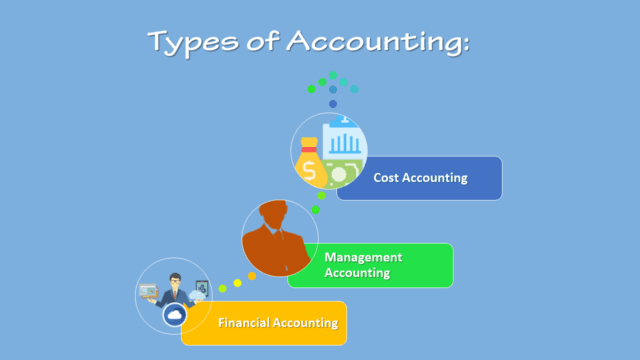The different types of Financial Accounting; Financial accounting classifies under the head of accounting functions that specifically maintain the financial transactions of companies; Accounting essay; Financial accounting explains the different types with their objectives or intentions or motives. The guidelines under accounting use to summarize and classify all transactions; It also involves preparing the financial statements of a company which gives an overview of the economic stability of a company to its investors.
This article can explain the Financial accounting different types with their objectives or intentions or motives.
This pertains to the recording of all business transactions in the books of prime entry, posting them into respective ledger accounts, balancing them, and preparing a trial balance, from and out of which a profit and loss account showing the results of the business and also a balance sheet depicting assets and liabilities of the business concern is prepared. This in turn forms the basis for analysis and interpretation for furnishing meaningful data to the management.
The Accounting essays in types of accounting are part, both methods rely on the same conceptual framework of double-entry accounting for recording and reporting analysis data at the end of a certain period; Two types or methods of financial accounting are cash and accrual or remedial account; Although they differ, both methods rely on the same conceptual framework as double-entry accounting for recording, analyzing, and reporting at the end of a given period of time; Such as a month, quarter or financial year.
The information generated by accounting is used by various interested groups such as individuals, managers, investors, creditors, government, regulatory agencies, taxation authorities, employees, trade unions, consumers, and the general public. Depending on the purpose and method, accounting can be broad of three types; 1] financial accounting, 2] cost accounting, and 3] management accounting. Financial accounting is mainly concerned with the preparation of financial statements. It is used on some well-defined concepts and conventions and helps formulate comprehensive financial policies.
Cash Account:
If you are the owner of a business, by adopting cash accounting you can only focus on corporate transactions involving cash. Other economic events with no monetary input do not matter because they do not make it to the financial statements. The business prefers to go for the cash accounting method only to focus on cash transactions that involve cash. Any other transaction that does not include any monetary value does not go into the financial statements.
Under this method, all-cash credit cash entries are based on the number of related loans and transactions carried out. Under the cash accounting method, a corporate bookkeeper always debits or credits the cash account in each journal entry on a transaction basis. For example, to record customer remittances, the bookkeeper debits the cash account and credits the sales revenue account. Do not mistake cash debit accounting for banking debit. The former means an increase in the company’s money, while the latter reduces the money in the customer’s account.
Accrual Account:
The records of the company maintain the transaction under all modes irrespective of any monetary value. It also involves making entries about cash which is beyond other transactions that do not include monetary transactions. The method acquired in financial accounting is depositing an item and recording it legally when a cash transaction occurs. Under the contingency method of accounting, a company records all transaction data regardless of monetary inflows or outflows.
In other words, this accounting type incorporates the cash accounting method but takes into account all transactions that carry out the operating activities of the corporation. In a financial dictionary, “earned” means an item to store and record as legally binding, even if there is no cash payment.
The phrases “accounts payable” and “accounts receivable” perfectly illustrate the concept of pronunciation. The accounting, also known as the payable seller, represents the amount of money that the seller of a business paid at a given point in time. The entity accrues the debtors until it settles the underlying debts. The same analysis applies to customers. Receivables are another name for accounts receivable that represent the money customers pay to a business.

Objectives or intentions or motives of financial accounting:
What are the intentions or motives of financial accounting? Knowing the goals of financial accounting can have the effect of being an accountant and truly understanding what your business is doing. Accounting Objectives; Accounting norms can appear to be unfamiliar and discretionary; however, by learning the calculated structure you will have a reasonable foundation to comprehend the hypothesis of accounting rules without falling back on repetition retention. The goal of financial accounting is to give data to the end-client; however, the calculated system, or Statements of Financial Accounting Concepts (SFAC), mentions to us what characteristics that data must-have.
Significance:
For data to be valuable to end-clients, it must be important. That implies that it must assistance a financial assertion peruser to settle on choices about the financial prosperity of the organization. For financial specialists, this verifiable think back serves to help settle on venture choices. To be important, data should likewise be current. Organizations report financial outcomes on a quarterly or yearly premise to fulfill this target. End-clients need the latest data conceivable to settle on the best choices.
Unwavering quality:
Accounting data must be solid. If an organization doesn’t create dependable financial proclamations, at that point speculators can’t pick up the data they have to decide. Dependable data can check, is liberated from predisposition, and isn’t deceiving. To assist organizations with meeting this goal, public bookkeepers will freely confirm accounting medicines and exchanges and issue conclusions dependent on these reviews. This makes end-clients more all right with their dependence on financial data.
It is both Reliability and Relevance; A significant target is to get ready for such financial proclamations that are dependable, and choices can found on it. For this reason, such Accounting should speak to a dependable portrayal of exchanges and occasions embraced by the business, ought to speak to in their genuine substance and monetary reality point of view.
Straightforward:
Among all the goals examined above, it is the essential target that Financial Accounts are set up so that they are effectively justifiable by proposed clients. Nonetheless, while meeting this goal as a primary concern; it must be similarly fundamental to guarantee that no material data discard because it will be mind-boggling and unwieldy to comprehend for different clients. To put it plainly, endeavors must make to plan Financial Accounts simply to know at every possible opportunity.
Similarity:
An auxiliary nature of financial data is that it must be equivalent. This is the reason we have a setup arrangement for recording and detailing accounting data. Financial specialists regularly are given decisions on where and when to contribute. By having tantamount information, these speculators can make relative decisions about their venture openings. Nonetheless, similarity, being an auxiliary quality, must take on a supporting role to pertinence and dependability.
Consistency:
Consistency is another auxiliary nature of financial data. Since end clients are frequently given financial data that traverses different timeframes; these clients should have the option to look at data across financial periods. As guidelines change, and as organizations change, it won’t generally be conceivable to have totally steady data. Be that as it may, when accounting data isn’t steady, norms require the revelation of the irregularity. This is a case of the essential nature of dependability taking a front seat to the optional nature of consistency.
Meeting the Objective of Various Stakeholders:
Another fundamental target is addressing the requirements of different partners, which are related to the business. Various partners have various purposes, for example; loan specialists to the business mean to evaluate the ability of the business to pay interest and head; which loan to the business or planned moneylenders; so they are more intrigued by the dissolvability of the business and spotlight on that perspective. Additionally, clients are keen on knowing the development and steadiness of the business and spotlight more on income explanations; and, financial articulations to decide the capacity of the business to give better business terms and a reliable gracefully of products and enterprises.















